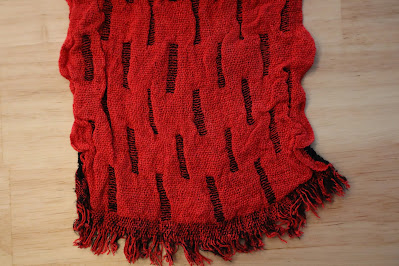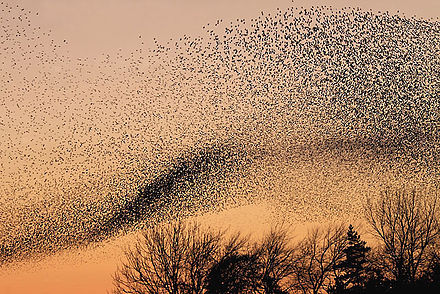Random Acts of Color
Sunday, June 22, 2025
A Tale of Three Looms
Thursday, May 22, 2025
A Saga of Silk in the Gum: Chapter 1, Winding the Warp
Thanks to the valiant de-stashing efforts of a friend, I now own about 3 ounces of raw silk organzine, which has a grist of about 18,700 yards per pound. It's wonderful yarn because it's reeled silk -- a.k.a. thrown silk or raw silk -- meaning it came straight from the cocoon. A single strand of silk filament from one cocoon typically ranges from 2,000 to 5,000 feet long. And it's very strong.
Silk reeled straight from the cocoon is still "in the gum." When the silkworm spins a cocoon, the filament it creates is coated in sericin -- a gummy substance that makes each ever-so-fine strand adhere to others, in order to create a sturdy, solid cocoon. To make silk yarn, these filaments are gathered to create one strand of silk, which is plied with another strand to create silk yarn. It's a very delicate, laborious process.
Even after it's spun into yarn (such as the yarn on the cone shown at the beginning of this post), silk in the gum is not easy to handle, because of its tendency to twist back on itself. Also, the stiffness of the yarn causes challenges: If it's not under tension and it's on a cone, it unravels all over the place, fast. Elastic socks (cut into a tube) don't help much, in my view. Neither do "yarn bras" (otherwise recognized as the green plastic webs we put over wine bottles to keep them from breaking). I use them to store the yarn, but not when I'm winding a warp.
(A slight but necessary digression: Nearly all of the silk used by weavers today is degummed, so that it's silky and shiny and gorgeous. Further, nearly all of the silk used by weavers today is spun silk, which is made from fiber left over from the reeling process or from damaged or imperfect cocoons. Spun silk is not as strong as reeled silk -- because the filaments are much shorter -- and for that reason it's much fuzzier, so it often pills. I've sometimes resorted to a seam ripper to separate two warp yarns that were bound together by one of these pills, or "nits," as I call them.)
In contrast, despite how tricky it is to handle, reeled silk is a genuine treasure, creating fabric with a drape and hand that's hard to find with any other yarn. Plus, it takes dye beautifully.
Again, back to the story. I've got this fine silk yarn in the gum and I want to degum it after weaving, using a shibori-resist technique, so that portions of the woven fabric will be degummed (becoming soft and shiny and pliable, like silk Habotai) while the rest of the fabric will still be in the gum and stiff (like silk organza). The idea is to create contrasts in texture -- a dimensional fabric -- with lots of interesting pleats and bumps.
Below is the pattern I plan to use. The red-colored ends in the drawdown show where I will add the shibori-resist yarns, yarns that I will pull tight and knot to create a sort of "package" of the fabric with tight accordion folds. When washed in soda ash and Orvus paste to remove the sericin (gum), the edges of the folds will be exposed to the solution while the interior of the folds will not. At least that's my theory. I'm going to weave up some small samples first, of course, because you never know. Best-laid plans and all...
You'll note that I've got red ends at the corners of the diamonds in both warp and weft. That's because I plan to sample it both ways: using warp tie-ups to create horizontal pleats and, for another sample, using weft tie-ups for vertical pleats. Once you draw the fabric in using these yarns (which have to be very strong or they'll break and ruin all that weaving), you will have a tight package of pleats ready for degumming. The pattern is #78120 from handweaving.net.
For the warp ends that I'll use as shibori ties, I plan on using this Nymo beading thread (shown below) because it Simply. Won't. Break. My fingers may hurt, but my shibori ties will be intact. Again, that's my plan.
But first I have to wind the warp. I called my friend, Deb Kaplan, a brilliant weaver from Boston, and asked her about winding the warp from cones -- knowing full well that it would be a challenge. She suggested I first wind the yarn onto spools, which I don't have so I substituted bobbins. She also suggested using a manual bobbin winder rather than an electric one, because a manual winder is slower, making it much easier to keep an even tension as I wind the bobbins.
You want the yarn to look like this as you wind it onto the bobbin.
Not like this. (Excuse the background. Weavers need stuff.)
To get just the right tension, you might want additionally to wind the yarn around a chair leg or anything rounded and handy. Here, I used part of a steel utility shelf.
Thursday, April 24, 2025
Now on Exhibit at the Handweaving Museum in Clayton, NY
I call this piece "Murmurations" because the intertwining curves remind me of the shape-shifting patterns of starlings.
Saturday, March 29, 2025
This Color Doesn't Exist

Monday, February 24, 2025
Some Notes from My New Lecture, 'You Can't Judge a Warp by Its Color'
A Tale of Three Looms
They're all dressed up (well, almost) but not ready to go! Pictured above: At top, my 16-shaft Toika Eeva, threaded for a differential...

-
I think it's Elvis Costello who said, "Writing about music is like dancing about architecture." You could say the same ...
-
Last Saturday at the Weaving and Fiber Arts Center, I taught a class on "Getting the Blues: Natural Dyeing with Indigo and Woad."...
-
In 1921, Johannes Itten -- a painter and teacher at Germany's famed Bauhaus School -- published The Color Star , a small book featurin...

































.jpg)


















